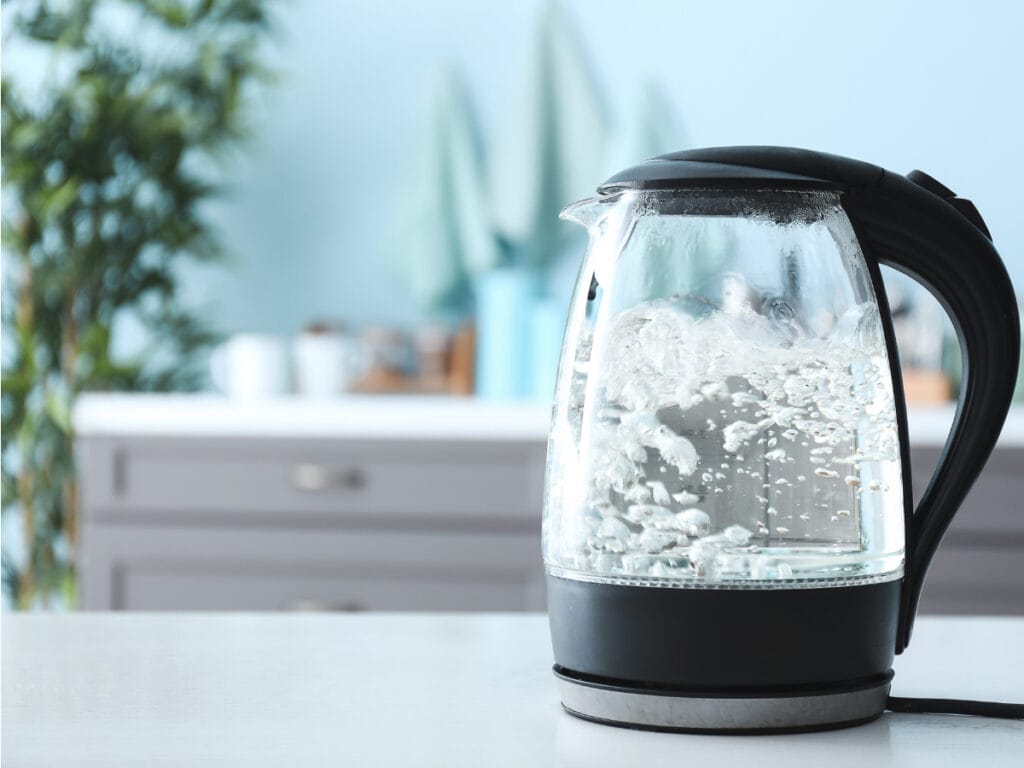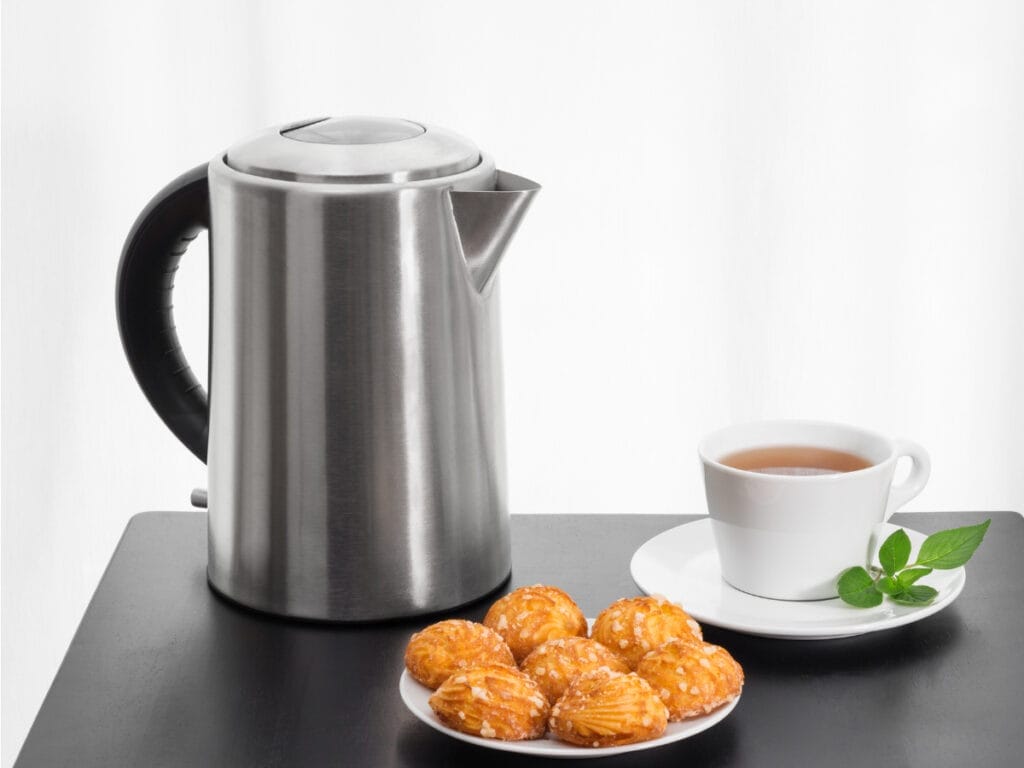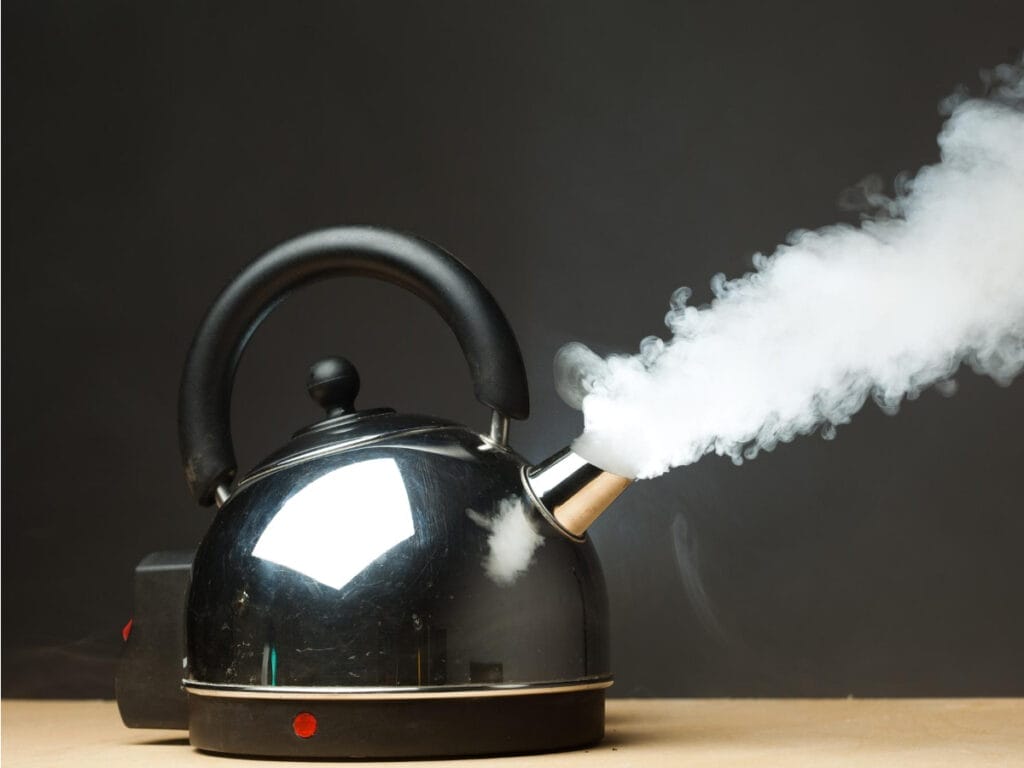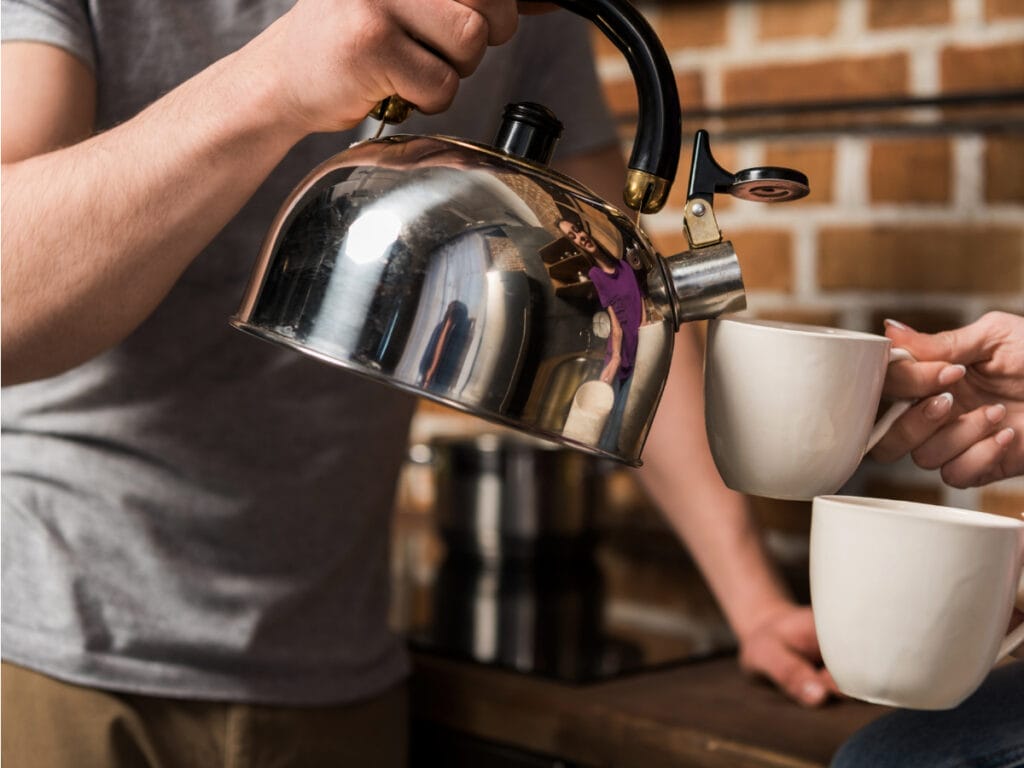This post contains affiliate links for which I may make a small commission to help keep the site running. You will not be charged extra for these items had you not clicked the links. Thank you for your help to keep the site running!
Wondering who invented the first electric kettle?
Kettles are a staple in almost every British kitchen, no matter the age, gender, social class, ethnicity (in fact, at least 95% of the country have them!), but how did they get there?
Often, Americans are confused about electric kettles, asking questions online about why the UK is “obsessed” with them, but the answer for the Brits is simple: it boils water quickly, which means you can keep on drinking those cups of tea all day long, and you can set it and forget it and walk away unlike other means of heating up water.

They’re also relatively inexpensive and they’re just efficient.
But let’s dive into some more British kettle facts, including the inventor of the electric kettle, history of kettle, and more!
Want the video version of this article?
Great British Kettle Surge

Did you know that electric companies can actually tell when a huge moment in British television is happening, or has just happened, due to the electric surge coming from everyone “putting their kettle on” at the same time?
I promise you, this is a real thing!
For instance, in 2010, Coronation Street, a British soap opera, did an episode all about a tram disaster, and the British public all raced to their kettles to make themselves a cup of tea to calm down because the National Grid noticed that the surge in demand at the end of Coronation Street was higher than usual.
Another example is that during King Charles’ coronation, the National Grid saw another huge spike that required the teams behind the scenes to make sure they balanced the electricity supply and demand with a close eye so all of those kettles didn’t disrupt the system.
This is also known as the “kettle on” effect or the “Great British kettle surge.”
It occurs more than you might think, and while each kettle itself doesn’t seem significant, it’s them being turned on simultaneously around the nation that creates this huge demand for electricity.
Often, during that time period, because of all the kettles turned on at the same time, the UK actually has to import energy from other countries to keep up with the demand – usually from France.
How Many British Households have Kettles?

From the most recent statistics, around 2017, about 95% of British households owned an electric kettle.
It’s fluctuated between 94 and 98 percent since 2005, but this is what I mean when I say that truly a majority of households own them.
And I’m not sure who that extra 5% are, but they clearly just moved to the UK and just haven’t purchased a kettle yet or something, or possibly they’re American expats who are still microwaving their water!
Wasted Energy from Kettles
Here’s another fun fact about kettles – while they are very efficient, there is a lot of wasted energy from them.
In 2013, the Energy Savings Trust estimated that 3 quarters of British households boil more water than necessary and that almost £68 million is spent on wasted energy every year – so don’t boil a full kettle if you don’t need it all!
Kettles in the British Military
One of the more interesting things about kettles in the UK was that the Brits were the first military to install boiling vessels into their tanks, a design that some other countries have now copied, and part of the original idea and need for it had to do with tea!
It is a myth that there exists complete tea making facilities or kettles within a British tank, but essentially what happened was during World War II, people started to notice that many casualties happened while the troops were outside the vehicles, stopped to use what was called a Benghazi burner, which was a can placed in a hole in the crowd with burning wood to heat rations, brew tea, and heat water for other things.
And of course, getting out and stretching your legs from being inside a cramped tank is a good thing for morale, but the problem is that you’re then exposed to the enemy and that’s never a good thing.
In fact, during the Battle of Normandy, 14 tanks were knocked out by the Germans within 15 minutes as British crews were outside their tanks on a tea and rest break.
So the Brits came up with the idea to include a boiling vessel inside of the tank, the first one being the Centurion, which was used just a few years after the Second World War.
It’s not a kettle, exactly, but works similarly, and now Brits could have access to hot water to make a cup of tea, boil their rations, and be able to clean things from within the tank.
A tank can even be considered out-of-operation if the boiling vessel isn’t working.
History of the Electric Kettle

Now let’s dive into the history of the electric kettle, because kettles themselves have been in use for a long, long time, but obviously the electric kettle has taken some time to make its way into kitchens across the UK.
For the start of tea kettle history, you should know that the word kettle itself originates from an Old Norse word meaning cauldron, and the first kettle-shaped item was found in Mesopotamia, dating back to between 3500 and 2000 BC.
For many years, kettles were heated over a flame, and silver kettles were a popular part of English tea tradition during the 1700s.
But by the 19th century, people had had enough of this inefficient way to heat water and things started to get more interesting.
Kettles switched from iron to copper because it’s a better conductor of heat, and in the 20th century, gas ovens with hobs – or stoves as we would say in America, meant that people could now use a kettle that was heated while sitting on the hob, directly from the flame of the gas ring if it was a gas oven and with a thicker ground base if it was an electric cooker.

The handle was now designed to not be as hot, so you could hold it without a cloth or other method of not burning your hand off like the ones that would hang over a fire, and you could actually now tell if the water was boiling because the steam would come from the spout and there was a “singing” sound of a kettle heated that would go quiet when the water was boiling.
After that comes the whistling kettle – it has a detachable whistle fitted over the spout that gave a whistling alarm when the water was boiling.
Now the electric kettle, using electricity to heat water rather than needing a hob, starts to change everyone’s lives – sort of – around 1890.
Funnily enough, though the US doesn’t really use electric kettles today, the Carpenter Electric Company in the US was one of the first to launch an electric kettle – this was in 1891.
Right around this time, a UK company, Crompton and Co, also released their own electric kettle model.
However, the heating element had to be housed separately to the water as it couldn’t be immersed in the water, so it was still pretty inefficient and it took over 10 minutes for the water to boil.
The credit for “creation of the electric kettle” actually goes to a man named Leslie Large, who worked for a company called Bulpitt & Sons in Birmingham (in the UK, not Alabama).

He wasn’t actually the first to create the electric kettle, as this doesn’t happen until 1922, 30 years after the first versions, but his design allows for a submersible electric heating element, similar to the electric kettles of today.
Obviously this is better than needing a separate compartment so that’s why he gets the credit because kettle users everywhere could breathe a sigh of relief that it was now much easier and faster to boil water for a cup of tea.
Today, modern kettles have a safety cut-off function that means that the kettle will stop boiling the water once it boils.
Essentially the heating connection is broken and electricity is prevented from reaching the element once it reaches boiling point.
This is much more practical for being able to actually walk away from the kettle and do other things, and if you forget about the kettle boiling – no problem, besides the knock to your electricity bill.
One major problem of stovetop and whistling kettles were that they would obviously keep boiling until someone manually turned off the heat, which meant that if you forgot about it you could end up with a burnt out kettle.
Kettles in the UK
Electric kettles are more common in commonwealth countries than in the US – I’ve mentioned multiple times before that Americans, in general, don’t really use electric kettles, so I hadn’t even seen one before moving to the UK, but British people are very proud of their kettles!
You can also buy Kettle themed merch from places like Etsy, including an “I’ll put the kettle on” poster and you can get a relatively plain and boring one like this that might be used in an office, or you can get super cutesy with ones like these.
